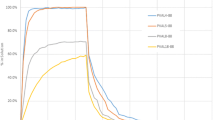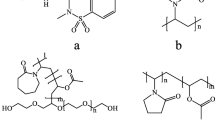Abstract
Purpose
To understand the mechanism of nano-crystalline drug formation in Pluronic® (i.e., poly(ethylene oxide-block-propylene oxide) triblock copolymers) based drug-polymer solid dispersions.
Materials and Methods
Four polymers, Pluronic® F127, F108, F68 and PEG 8000, which have different poly(ethylene oxide) (PEO) and poly(propylene oxide) (PPO) ratio and chain length, were co-spray dried with BMS-347070, a COX-2 inhibitor, to form 50/50 (w/w) drug-polymer solid dispersions. The solid dispersions were analyzed by powder X-ray diffraction (PXRD), modulated differential scanning calorimetry (mDSC), and hot-stage microscopy. Average size of drug crystallites in different polymers was calculated by the Scherrer equation based on peak-broadening effect in PXRD. Two other drug compounds, BMS-A and BMS-B, were also spray dried with Pluronic® F127, and the solid dispersions were analyzed by PXRD and mDSC.
Results
The average size of BMS-347070 crystallites in PEG 8000, F127, F108 and F68 polymers was 69, 80, 98 and 136 nm, respectively, and the degree of BMS-347070 crystallinity is the lowest in PEG 8000. Hot-stage microscopy showed that 50/50 drug-polymer dispersions crystallized in a two-step process: a portion of the polymer crystallizes first (Step 1), followed by crystallization of drug and remaining polymer (Step 2). The T g value of the BMS-347070/Pluronic® dispersions after Step 1 (i.e., T g1) was measured and/or calculated to be 15–26°C, and that of BMS-347070/PEG 8000 was 60°C. Solid dispersions of BMS-A and BMS-B in Pluronic® F127 have T g1 of 72 and 3°C, respectively; and PXRD showed BMS-A remained amorphous after ∼3 weeks under ambient condition, while BMS-B crystallized in F127 with an average crystallite size of 143 nm.
Conclusions
The size of drug crystallites in the drug-polymer solid dispersions is independent of polymer topology, but is caused kinetically by a combined effect of nucleation rate and crystal growth rate. When drug-Pluronic® solid dispersions crystallize at room temperature, that is close to the T g1 of the systems, a fast nucleation rate and a relatively slow crystal growth rate of the drug synergistically produced small crystallite size. While the much higher T g1 value of drug-PEG 8000 led to a slower nucleation rate and an even slower crystal growth rate at room temperature, therefore, small crystallite size and low drug crystallinity were observed. Results from BMS-A/Pluronic® and BMS-B/Pluronic® systems confirmed this kinetic theory.





Similar content being viewed by others
References
O. Chambin and V. Jannin. Interest of multifunctional lipid excipients: case of Gelucire 44/14. Drug Dev. Ind. Pharm. 31:527–534 (2005).
J. Hu, K. P. Johnston, and R. O. Williams, III. Nanoparticle engineering processes for enhancing the dissolution rates of poorly water soluble drugs. Drug Dev. Ind. Pharm. 30:233–245 (2004).
C. Leuner and J. Dressman. Improving drug solubility for oral delivery using solid dispersions. Eur. J. Pharm. Biopharm. 50:47–60 (2000).
E. Merisko-Liversidge, G. G. Liversidge, and E. R. Cooper. Nanosizing: a formulation approach for poorly-water-soluble compounds. Eur. J. Pharm. Sci. 18:113–120 (2003).
A. T. Serajuddin. Solid dispersion of poorly water-soluble drugs: early promises, subsequent problems, and recent breakthroughs. J. Pharm. Sci. 88:1058–1066 (1999).
S. Sethia and E. Squillante. Solid dispersions: revival with greater possibilities and applications in oral drug delivery. Crit Rev. Ther. Drug Carrier Syst. 20:215–247 (2003).
N. Subramanian and S. K. Ghosal. Enhancement of gastrointestinal absorption of poorly water soluble drugs via lipid based systems. Indian J. Exp. Biol. 42:1056–1065 (2004).
A. Martin. Physical Pharmacy, Lippincott Williams & Wilkins, Baltimore, MD, 1993.
S. X. Yin, M. Franchini, J. Chen, A. Hsieh, S. Jen, T. Lee, M. Hussain, and R. Smith. Bioavailability enhancement of a COX-2 inhibitor, BMS-347070, from a nanocrystalline dispersion prepared by spray-drying. J. Pharm. Sci. 94:1598–1607 (2005).
L. E. Alexander and Klug HP. X-ray Diffraction Procedures-for Polycrystalline and Amorphousmaterials, Wiley, New York, 1974.
T. G. Fox. Influence of diluent and of copolymer composition on the glass transition temperature of a polymer system. Bull. Am. Phys. Soc. 1:123 (1956).
A. Kabanov, J. Zhu, and V. Alakhov. Pluronic block copolymers for gene delivery. Adv. Genet. 53:231–261 (2005).
A. V. Kabanov and V. Y. Alakhov. Pluronic block copolymers in drug delivery: from micellar nanocontainers to biological response modifiers. Crit Rev. Ther. Drug Carrier Syst. 19:1–72 (2002).
G. S. Kwon. Polymeric micelles for delivery of poorly water-soluble compounds. Crit Rev. Ther. Drug Carrier Syst. 20:357–403 (2003).
C.S. Yang, D.D. Awschalom, and G.D. Stucky. Growth of CdS nanorods in nonionic amphiphilic triblock copolymer systems. Chem Mater. 14:1277–1284 (2002).
J. W. Mullin. Crystallization, Butterworth-Heinemann, Oxford, 2001.
D. W. Oxtoby. Nucleation of first-order phase transitions. Acc. Chem. Res. 31:91–97 (1998).
M. Volmer. Kinetik der Phasenbildung, Leipsig, Steinkopff, 1939.
M. C. Weinberg. A few topics concerning nucleation and crystallization in glasses. J. Non-Crystalline Solids 255:1–14 (1999).
Acknowledgement
The authors thank Dr. Shawn Yin and Ms. Anisha Patel for assistance with PXRD and helpful discussion.
Author information
Authors and Affiliations
Corresponding author
Additional information
Authors Feng Qian and Jing Tao contributed equally to this study
Rights and permissions
About this article
Cite this article
Qian, F., Tao, J., Desikan, S. et al. Mechanistic Investigation of Pluronic® Based Nano-crystalline Drug-polymer Solid Dispersions. Pharm Res 24, 1551–1560 (2007). https://doi.org/10.1007/s11095-007-9275-7
Received:
Accepted:
Published:
Issue Date:
DOI: https://doi.org/10.1007/s11095-007-9275-7




